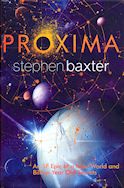Stephen Baxter's ambitious Xeelee sequence spans the entire lifetime
of the universe. This collection of short stories, some of which are
extensively fixed-up from their first publication, highlights moments from
that history. At the end a useful timeline helps to keep the reader
oriented.
If you like your stories short on characterisation, but long on hard
science, with the odd paragraph of lecturing thrown in here and there --
"A complex massive Klein-Gordon scalar field will be produced,
with no self-interaction save through gravity..." -- then these
are for you. I particularly enjoyed the early "hard biology"
stories, set a couple of thousand years in the future, with humans
exploring the Solar System, and finding bizarre life forms everywhere.
(These to me felt like a cross between Stanley Weinbaum and
Bob Forward.) The latter stories veer more
towards "hard physics" tales, as the war between baryonic life
and dark matter life results in some mind-boggling engineering feats.
I have a few small niggles: I find it hard to believe that in 3500
years' time, people will still have names like Eve and Jack,
and that they will talk in terms of the Lynden-Bell analysis of the
Jeans instability, and other 20th century physics concepts. But these
are fairly minor quibbles: the stories are fun and interesting.
Contents
- • The Sun-People. == The Sun-Person. 1993
- Sculptor 472 is born in changing times. The Sun People are destroying their way of life.
- • The Logic Pool. 1994
- Godel's incompleteness theorem shows we will always be able to add new axioms to our mathematical systems: but which ones should we add?
- • Gossamer. 1995
- Pluto and Charon are tidally locked -- which might allow an interesting evolutionary development.
- • Cilia-of-Gold. 1994
- One crater on sun-scorched Mercury is always in the dark, safe from the sun.
- • Lieserl. 1993
- There's something wrong with the sun, so Lieserl has to grow up fast.
- • Pilot. == ~~ Chiron. 1993
- Anna Gage goes to Chiron, and then even further, to escape the Squeem Occupation.
- • The Xeelee Flower. 1987
- How Jones made a discovery that helped end the Squeem Occupation.
- • More Than Time or Distance. 1988
- A human and an alien discover a Xeelee instantaneous communication artifact -- who will get to keep this priceless treasure?
- • The Switch. 1990
- Xenotechnologists are always on hand to look for Xeelee artifacts, but aren't always the most popular crew members.
- • Blue Shift. 1989
- Jim Bolder is employed by the Qax to fly a Xeelee ship to the Great Attractor.
- • The Quagma Datum. 1989
- Luce investigates the ancient Lithium-7 event, beating the Silver Ghosts to the race by using the new Supersymmetry drive.
- • Planck Zero. 1992
- Jack Raoul discovers the Silver Ghosts are experimenting with quagma, which might bring down the wrath of the Xeelee on everyone.
- • The Godel Sunflowers. 1992
- What is the secret of the giant Snowflake artifact?
- • Vacuum Diagrams. 1990
- The strange human Paul is linked somehow to the Xeelee "Sugar Lump" -- a giant cubical artifact.
- • Stowaway. == (rev. from Raft). 1991
- Rees is born a miner, seemingly condemned to a short harsh life in cripplingly high gravity. But he stows away on the strange supply vessel.
- • The Tyranny of Heaven. 1990
- The enormous star fleet, the Exaltation of the Integrality,
makes its way to Bolder's Ring, preaching a message of peace with the
Xeelee to all it finds on its way.
- • Hero. 1995
- Modified humanity has regressed after the Core Wars, but there is still a Hero with his suit to save people.
- • Shell. == ~~ The Bark Spaceship. 1987
- Young Allel dreams of travelling from Home to the Shell overhead.
- • The Eighth Room. 1989
- The Sun is cooling, dying. Teal tries to fix it, but fails. Then his grandmother Allel tells him of the fabled Eighth Room in the north
- • Secret History. 1991
- The Xeelee project is complete, and Paul discovers what the Sugar Lump is for.
- • The Baryonic Lords. 1991
- Erwal rediscovers the Eighth Room, and the waiting spaceship. But she doesn't know that the Qax are lying in wait.
- • Eve. == The Soliton Star. 1996
- Linking story used as (very slight) glue to hold the rest together as a future history.








